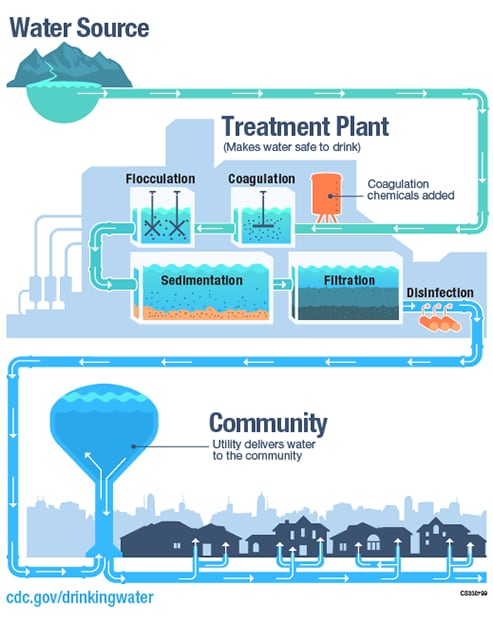Water Treatment
How Water Treatment Plants Make Water Safe
Public drinking water systems use different water treatment methods to provide safe drinking water for their communities. Public water systems often use a series of water treatment steps that include coagulation, flocculation, sedimentation, filtration, and disinfection.
Water treatment steps
Coagulation
Coagulation is often the first step in water treatment. During coagulation, chemicals with a positive charge are added to the water. The positive charge neutralizes the negative charge of dirt and other dissolved particles in the water. When this occurs, the particles bind with the chemicals to form slightly larger particles. Common chemicals used in this step include specific types of salts, aluminum, or iron.
Flocculation
Flocculation follows the coagulation step. Flocculation is the gentle mixing of the water to form larger, heavier particles called flocs. Often, water treatment plants will add additional chemicals during this step to help the flocs form.
Sedimentation
Sedimentation is one of the steps water treatment plants use to separate out solids from the water. During sedimentation, flocs settle to the bottom of the water because they are heavier than water.
Filtration
Once the flocs have settled to the bottom of the water, the clear water on top is filtered to separate additional solids from the water. During filtration, the clear water passes through filters that have different pore sizes and are made of different materials (such as sand, gravel, and charcoal). These filters remove dissolved particles and germs, such as dust, chemicals, parasites, bacteria, and viruses. Activated carbon filters also remove any bad odors.
Water treatment plants can use a process called ultrafiltration in addition to or instead of traditional filtration. During ultrafiltration, the water goes through a filter membrane with very small pores. This filter only lets through water and other small molecules (such as salts and tiny, charged molecules).
Reverse osmosisexternal icon is another filtration method that removes additional particles from water. Water treatment plants often use reverse osmosis when treating recycled waterexternal icon (also called reused water) or salt water for drinking.
Disinfection
After the water has been filtered, water treatment plants may add one or more chemical disinfectants (such as chlorine, chloramine, or chlorine dioxide) to kill any remaining parasites, bacteria, or viruses. To help keep water safe as it travels to homes and businesses, water treatment plants will make sure the water has low levels of the chemical disinfectant when it leaves the treatment plant. This remaining disinfectant kills germs living in the pipes between the water treatment plant and your tap.
In addition to or instead of adding chlorine, chloramine, or chlorine dioxide, water treatment plants can also disinfect water using ultraviolet (UV) light pdf icon[PDF – 7 pages]external icon or ozone pdf icon[PDF – 7 pages]external icon. UV light and ozone work well to disinfect water in the treatment plant, but these disinfection methods do not continue killing germs as water travels through the pipes between the treatment plant and your tap.
Water treatment plants also commonly adjust water pH and add fluoride after the disinfection step. Adjusting the pH improves taste, reduces corrosion (breakdown) of pipes, and ensures chemical disinfectants continue killing germs as the water travels through pipes. Drinking water with the right amount of fluoride keeps teeth strong and reduces cavities.
Surface water collects on the ground or in a stream, river, lake, reservoir, or ocean.
Ground water is located below the surface of the earth in spaces between rock and soil.
Water treatment differs by community
Water may be treated differently in different communities depending on the quality of the source water that enters the treatment plant. The water that enters the treatment plant is most often either surface water or ground water. Surface water typically requires more treatment and filtration than ground water because lakes, rivers, and streams contain more sediment (sand, clay, silt, and other soil particles), germs, chemicals, and toxins than ground water.
Some water supplies may contain radionuclides (small radioactive particles), specific chemicals (such as nitrates), or toxins (such as those made by cyanobacteria). Specialized methods to control or remove these contaminants can also be part of water treatment. To learn more, visit EPA’s Ground Water and Drinking Water siteexternal icon.
- Water Disinfection with Chlorine and Chloramine
- Well Treatment
- Community Water Fluoridation
- A Guide to Drinking Water Treatment Technologies for Household Use
- EPA: Drinking Water Distribution Systemsexternal icon
- EPA: Drinking Water Regulationsexternal icon
- EPA: Drinking Water Contaminantsexternal icon
